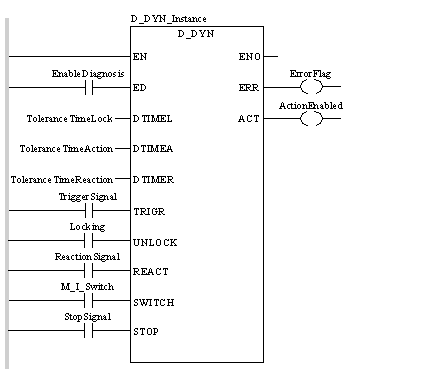|
Description
|
|
|
(Original Document)
|


CAL D_DYN_Instance (ED:=EnableDiagnosis,
DTIMEL:=ToleranceTimeLock,
DTIMEA:=ToleranceTimeAction,
DTIMER:=ToleranceTimeReaction,
TRIGR:=TriggerSignal, UNLOCK:=Locking,
REACT:=ReactionInput, SWITCH:=M_I_Switch,
STOP:=StopSignal, ERR=>ErrorFlag,
ACT=>ActionEnabled)
D_DYN_Instance (ED:=EnableDiagnosis,
DTIMEL:=ToleranceTimeLock,
DTIMEA:=ToleranceTimeAction,
DTIMER:=ToleranceTimeReaction,
TRIGR:=TriggerSignal, UNLOCK:=Locking,
REACT:=ReactionInput, SWITCH:=M_I_Switch,
STOP:=StopSignal, ERR=>ErrorFlag,
ACT=>ActionEnabled) ;
|
Parameter
|
Data type
|
Meaning
|
|---|---|---|
|
ED
|
Enable diagnostics
|
|
|
DTIMEL
|
Tolerance time D_LOCK (locking diagnostics)
|
|
|
DTIMEA
|
TIME
|
Tolerance time D_ACT (action diagnostics)
|
|
DTIMER
|
TIME
|
Tolerance time D_REA (reaction diagnostics)
|
|
TRIGR
|
BOOL
|
Trigger
|
|
UNLOCK
|
BOOL
|
Lock
|
|
REACT
|
BOOL
|
Reaction signal
|
|
SWITCH
|
BOOL
|
M/I switch; 0: M behavior, 1: I behavior, 0/1: MI behavior
|
|
STOP
|
BOOL
|
Stop signal
|
|
Parameter
|
Data type
|
Meaning
|
|---|---|---|
|
ERR
|
BOOL
|
Error message; 0: No error; 1: Error
|
|
ACT
|
BOOL
|
Action enabling
|
|
Parameter
|
Data type
|
Meaning
|
|---|---|---|
|
AREA_NR
|
Automation area to be monitored.
This byte specifies which area will be monitored by the diagnostic EFB.
It is advisable to assign the numbers according to the functional modules.
Values: 0 ... 15. The standard value is 0.
Example:
In the example AREA_NR must have the value 1, 2 or 3, so that they can recognize the error affected area.
|
|
|
OP_CTRL
|
BOOL
|
This bit specifies whether a diagnostic event will request a user acknowledgement.
The standard value is 0.
|